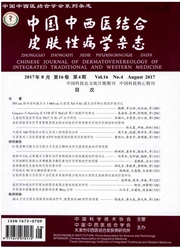

 中文摘要:
中文摘要:
目的 评价温经汤加减治疗宫寒血瘀型青春期后痤疮的疗效。方法 采用随机对照的方法,将符合纳入标准的64例研究对象按1∶1随机分入治疗组和对照组,治疗组予口服温经汤加减,对照组予口服达英-35。治疗2个疗程后观察临床症状、血清睾酮水平在治疗前后的改变。结果 治疗后2组的丘疹、脓疱、脂溢评分均较治疗前降低,差异有统计学意义(P〈0.05)。治疗后2组的血清睾酮水平均较治疗前明显下降,差异有统计学意义(P〈0.05)。治疗组治疗后的粉刺、丘疹、脓疱、脂溢评分和血清睾酮水平与对照组治疗后比较,差异无统计学意义(P〉0.05)。结论温经汤加减治疗宫寒血瘀型女性青春期后痤疮疗效确切,可降低血清睾酮水平,其作用机制可能与拮抗雄激素受体或是雄激素相关代谢途径等有关。
 英文摘要:
英文摘要:
Objective In order to evaluate the efficacy of Wenjing Tang in the treatment of postadolescent acne with uterine cold blood stasis type. Methods A randomized control trial was applied. Sixty-four eligible patients with postadolescent acne with uterine cold blood stasis type were randomly divided into treatment group and control group in ratio of 1:1. The treatment group was given Wenjing Tang, and the control group was given Diane-35. After two treatment courses, the symptoms and the level of testosterone were analyzed and compared. Results After treatment, the two groups had lower score than before the treatment in points of clinical symptoms (including papule, pustule and oil secretion), the differences were statistically significant (P〈0.05). After treatment, the two groups had lower score than before the treatment in points of the level of testosterone, the differences were statistically significant (P〈0.05). Compared with the control group, the clinical symptoms (including whelk, papule, pustule and oil secretion) and the level of testosterone in treatment group had no statistically significant differences after treatment (P〉0.05). Conclusion Wenjing Tang has significant clinical efficiency on postadolescent aene with uterine cold blood stasis type. It can reduce the level of testosterone. Its mechanism may be associated with antagonism androgen receptor or androgen metabolic pathway and so on.
 同期刊论文项目
同期刊论文项目
 同项目期刊论文
同项目期刊论文
 期刊信息
期刊信息
